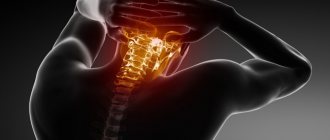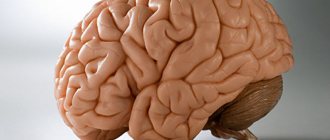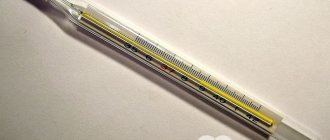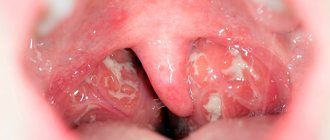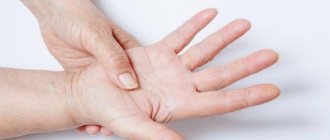Noise in the right or left ear is not an independent type of disease.
And one of the clinical manifestations of a particular disease.
In medical terminology, it is commonly called “tinnitus.”
Find the answer
Are you having any problem? Enter “Symptom” or “Name of the disease” into the form, press Enter and you will find out all the treatment for this problem or disease.
The site provides reference information. Adequate diagnosis and treatment of the disease is possible under the supervision of a conscientious doctor. Any medications have contraindications. Consultation with a specialist is required, as well as detailed study of the instructions! Here you can make an appointment with a doctor.
Noise in the right ear - causes
Noise in the ear occurs due to irritation of hair-type cells, which are localized in large numbers in the area of the inner ear.
Under normal conditions, their functioning occurs synchronously and does not cause any unpleasant sensations. After their irritation, the movements of the hairs will be unsynchronized, and the order in which electrical excitation impulses enter the brain is quickly disrupted, which is why tinnitus appears.
There is also something called physiological noise. This situation is explained by the noise of blood that passes through the area of the inner ear, hitting the walls of the vessels located there.
The noise occurs in conditions of complete silence and happens on both sides, and only in one ear.
In most cases, tinnitus is a clinical sign of a disease, for example, acute otitis media, sensorineural hearing loss, or Meniere's disease.
Among the reasons leading to tinnitus:
- Changes in blood pressure levels;
- Vegetative-vascular dystonia;
- Atherosclerosis of cerebral vessels;
- Traumatic brain injury;
- Brain tumors of a malignant nature;
- Poisoning with various toxic substances.
In fifteen percent of cases, tinnitus is caused by pathology of the hearing aid. In all other situations (with the exception of physiological noise), the etiological factor is associated with a general disease.
Often, severe noise in the right ear is a sign of acute right-sided otitis or acute right-sided tubo-otitis. The noise is accompanied by unpleasant, painful sensations in the ear area and a feeling of stuffiness.
With otitis media, the noise is associated with the accumulation of fluid in the middle ear cavity, called exudate. In the case of Meniere's disease, the noise occurs due to a sharp spasm of the small arteries supplying this area and a violation of blood circulation.
In parallel with noise, illness, a person will be bothered by dizziness, a sharp loss of balance and a gradual decrease in hearing. If the noise is caused by right-sided tubo-otitis or inflammation of the auditory tube, then along with tinnitus there will be severe congestion in the ear.
Noise in the right ear may occur when taking medications that have an ototoxic effect; this group includes some antibacterial drugs.
Name of tablets for noise in the head
But not only tablets are used to treat noise in the ears and head. Basically, only an integrated approach is quite effective. This includes working with a psychotherapist, cardiologist, and endocrinologist. That is, it is necessary for all specialists to work together. The help of a neurologist is often required, who prescribes treatment to improve blood circulation in the cervical vertebrae. This can be massage, non-steroidal anti-inflammatory drugs, as well as chondroprotectors that prevent the destruction of bone tissue.
To treat ear pathologies, antibiotics and decongestants will be prescribed. Antihistamines usually help.
Tablets for hearing pathologies:
- Loratadine
- Serrata
- Eden
Name of tablets for noise in the head:
- Nifedipine
- Lisinopril
- Verapamil
These are drugs for relaxing blood vessels. Often prescribed for high blood pressure and atherosclerosis.
Tranquilizers may also be prescribed as medications. However, they are indicated in extreme cases when serious changes in brain tissue are observed. Basically, special therapy is prescribed, which is aimed at a kind of refusal to listen to noise in the head. Thus, a person is taught not to pay attention to this noise. This is done using special therapy using sound waves of a certain frequency. Quite useful in treating tinnitus in the ears is the use of white noise. This is a noise that sounds in reality and prevents the ear from perceiving the noise inside the head.
Ringing
Types of noise
The noise happens:
- Throbbing. It may occur:
- With Meniere's disease;
- Aneurysm of the ear artery;
- Neoplasms in the ear cavity;
- For otitis and eustacheitis.
- Clicking noise. A clicking noise can occur with frequent sharp contractions of the middle ear and soft palate. Such a noise may appear during convulsive readiness.
- Simple, in the form:
- Hissing;
- Clicking;
- Buzzing;
- Whistling.
- Difficult:
- In the form of voices;
- Music;
- Sounds.
The last type of noise relates more to the field of psychiatry; it can be a type of hallucination.
Diagnosis of the disease
If you are suffering from ringing or noise in the ears, it is better to visit a doctor and undergo an examination that will reveal the cause of the disease. First of all, you should visit your local physician, and then an otolaryngologist or neurologist, depending on the existing ailment.
To clarify the diagnosis, a patient with the symptoms in question is prescribed the following examination methods:
- General and biochemical blood test. This includes a blood test for tumor markers to be able to detect a cancer tumor in a timely manner.
- CT and MRI of the brain. They give the most accurate results when identifying disorders in the brain. In addition, they help identify brain tumors, even negligibly small ones.
- MRI of the spine. Helps assess the condition of the spinal column and identify the presence of osteochondrosis, protrusions, hernias and disc displacements.
- Angiography of blood vessels. Allows you to detect the presence of atherosclerotic plaques in the blood channels supplying the brain.
- Audiogram. Allows you to determine hearing acuity in each ear.
If specialists do not find acute or chronic diseases in the body, the patient will be referred to a psychotherapist, because it is quite possible that tinnitus appeared as a result of depression and obsessions.
How to get rid of pathology
How to get rid of noise in the right ear?
To get rid of this problem, you must first find out what caused the noise in the ear. It is necessary to undergo a set of diagnostic measures, including:
- Visit to an otorhinolaryngologist;
- Vascular ultrasound;
- X-ray of the skull and upper parts of the spinal column;
- Computed tomography of the skull.
After the examinations, the specialist will be able to make the correct diagnosis and prescribe the correct treatment.
Prevention of tinnitus and head noise
Scientists have proven that ringing in the ears mainly occurs in people who are prone to obesity and who have high cholesterol levels in the blood. Therefore, it is important to pay attention to prevention.
Prevention of noise in the ears and head:
- Try to listen to less music on headphones at high volumes. After all, too loud a sound can reduce hearing and increase the likelihood of tinnitus.
- Use earplugs in hazardous work. Often, when a tire explodes, a very loud sound is heard, which can cause deafness and, consequently, tinnitus. If you sometimes manage to get rid of deafness quickly enough, then tinnitus can accompany you for the rest of your life.
- Be sure to treat inflammatory diseases of the respiratory and hearing organs. After all, any sinusitis, sinusitis and otitis media can cause inflammatory diseases of the middle ear, as a result of which you can hear gurgling noise in your head.
Ringing
Effective Treatments
The method of treating ear noise depends on the cause that caused it.
Often, therapy for this condition is complex and consists of taking a course of medications with metabolic, sedative, vascular and anti-inflammatory effects. In case of circulatory disorders, drugs that stimulate blood flow through the vessels have a good effect, these are Cavinton, Betahistine and others.
In case of otitis development, the doctor prescribes antibacterial agents taking into account the sensitivity of the microorganism that caused this process, antihistamines designed to relieve swelling and reduce the amount of exudative fluid in the middle ear.
This group includes:
- Promethazine;
- Hydroxyzine;
- Fenkarol.
Nootropic drugs have a good effect on tinnitus:
- Cortexin;
- Phezam;
- Mexidol.
In parallel with drug therapy, the doctor may prescribe a visit to the physiotherapy room, where the following medical procedures can have a good effect:
- Electrophoresis;
- Laser therapy;
- Pneumomassage of the eardrum.
From alternative medicine, we can separately mention anti-stress therapy, hydrotherapy or psychocorrection sessions.
Why is there noise?
This symptom in official medicine is called tinnitus. It is noted that in most cases, people over 40 years old turn to doctors with a similar problem, although noise or ringing in the ears can appear even in children. The reasons for this phenomenon are the most unexpected:
Blockage of the ear canal
The simplest problem that causes tinnitus is blockage of the ear canal with wax, water or a foreign body. In this case, the specialist only needs to rinse the ear or remove the foreign object so that the problem no longer bothers you. But you shouldn’t try to free the ear canal yourself. Such attempts can only worsen the situation.
Injuries and damage
Any injury to the head, middle ear, or eardrum can cause the noise. The problem can be triggered by a fall, a strong blow, or a sharp jump in atmospheric pressure. The noise in this case may be accompanied by a decrease and even loss of hearing.
Inflammation in the ears or head
These include inflammation of the auditory nerve, meningitis, brain and neck tumors. As a result of inflammation, the blood vessels that supply the brain with oxygen are compressed, resulting in oxygen starvation, which manifests itself as tinnitus.
Problems with the vestibular system
Tinnitus may occur as a result of a malfunction in the vestibular apparatus, which is responsible for coordinating movements. In this case, an unpleasant symptom occurs when bending and turning the head sharply.
Spinal problems
Instability of the spine, as well as diseases of the spinal column, such as osteochondrosis or hernia, put pressure on the vessels, cutting off the blood supply, which causes an unpleasant symptom. Moreover, this noise develops gradually and is constant, causing a person’s addiction and characterized by late consultation with a doctor.
Cardiovascular diseases
There are a number of diseases that manifest themselves as ringing in the head, as well as buzzing, tics, or tinnitus. These include:
- Atherosclerosis. By settling on the walls of blood vessels, cholesterol plaques narrow the lumen, disrupting the blood supply to the brain. This problem manifests itself as pulsation in the ear.
- Anemia. Anemia also causes this unpleasant symptom, which is complemented by poor health, weakness, apathy and dizziness. However, very often this cause of tinnitus remains undiagnosed.
- Hypertension. High blood pressure can develop for many reasons, including atherosclerosis, kidney disease, physical strain or stress. But whatever the reason for this phenomenon, high blood pressure is accompanied by pulsation and ringing in the ears.
- Vegetative-vascular dystonia. With this disease, blood pressure is low, leading to insufficient blood supply to organs, including the brain. Developing hypoxia in this case is manifested by tinnitus.
- Stroke. Pulsation in the ears, as well as strong ringing, is one of the precursors of the development of an acute cerebrovascular accident called a stroke. This situation requires immediate medical attention and emergency medical care.
Increased sensitivity to auditory sensations
This anomaly develops against the background of stress, nervous tension and neurotic conditions.
Taking medications
Tinnitus can be a side effect of medications. These include antidepressants, diuretics, antibiotics, NSAIDs, and heart medications. Noise and ringing in the head can also occur with prolonged use of salicylates or quinine.
Effect of electromagnetic rays
The development of tinnitus can be influenced by prolonged conversations on a mobile phone. Research into the effects of electromagnetic rays on the human brain has been going on for a long time, and scientists never tire of repeating that prolonged use of the phone leads to headaches, hearing problems, decreased concentration and reproductive dysfunction. And one of the symptoms of such a negative impact is tinnitus.
In addition to the listed diseases, noise in the ears and head results in:
- vitamin deficiency and iodine deficiency in the body;
- diabetes mellitus and other metabolic disorders;
- thyroid diseases;
- age-related hearing loss;
- Meniere's syndrome.
Traditional medicine
- A decoction of lemon balm has a good effect. You need to take a small bunch of fresh or dried lemon balm and fill it with one glass of hot water. After an hour, the broth should be strained and cooled. You need to drink half a glass 2 times a day.
- Traditional medicine recommends using ear drops made from vegetable juice:
- Grate the boiled beets and squeeze out the juice from the resulting mass, instill it 3 times a day, 2 drops;
- Bake a small onion in the oven until half cooked and squeeze out all the juice, instill it 2 times a day, one drop at a time.
- Bay leaf effectively helps fight tinnitus. To make the product, you need to take about ten grams of laurel leaf and pour 50 milliliters of warm sunflower oil into it. The mixture should sit for several hours. Then it can be instilled 3 drops every six hours.
- For noise in the ear, a decoction made from fresh dill works well. To do this, pour boiling water over a small bunch of dill and let it brew for about 2-3 hours. This remedy should be taken half a glass orally thirty minutes before meals.
Varieties
Clinicians distinguish 4 types of tinnitus:
- subjective _ In this case, the noise is heard exclusively by the sick person;
- objective - the noise is heard not only by the sick person, but also by his attending physician. In medical practice, this type is the least common;
- not vibrating . Only the patient hears various pathological sounds. They usually occur due to irritation of the nerve endings in the hearing aid;
- vibrating _ The sounds are reproduced by the hearing aid itself and can be heard not only by the patient, but also by his doctor.
Loud noises on the right
Noise in the ear can appear on either side, it does not need to be on the right, it often occurs in both ears at the same time. This phenomenon is not always a consequence of pathologies. This annoying manifestation occurs due to the huge number of hair cells located in the inner ear, and their synchronous activity does not cause discomfort. Failure and pain occur as a result of erratic flow of electrical impulses into the brain.
On the right side, strong noise in the ear is a consequence of:
- Right-sided otitis - discharge and fluid fill the middle ear, creating pressure on the eardrum, which leads to noise effects;
- Acute tubo-otitis - inflammation of the mucous membrane of the Eustachian tube simultaneously with the eardrum; this complication causes severe pain and a feeling of congestion;
- Meniere's disease is an inflammation of the inner ear with fluid accumulation. The disease is complicated by poor circulation due to compression of the blood arteries, which results in decreased hearing, dizziness and loss of balance;
- Abuse of a certain type of antibacterial drugs, which leads to an ototoxic effect and noise in the ear on the right side of the head;
- Other reasons - cerumen plug, foreign body, malignant and benign formations, injuries, bruises and other problems on the right side of the head;
- Cardiovascular problems.
Noises come in different forms and appear as:
- Pulsations, for example, with otitis media, Meniere's disease, arterial aneurysm, the appearance of a tumor, eustachitis;
- Clicking sounds, the soft palate and middle ear contract sharply and actively by clicking;
- Simple sounds - hissing, clicking, whistling, buzzing;
- Complex - the sound of music and voices, which can sometimes indicate mental disorders.
All these phenomena cause unbearable suffering to the patient, worsening hearing abilities, providing insomnia, irritation and other neurotic complications.
The appearance of a strong sound effect is an undeniable reason to visit a doctor, who will conduct the necessary research and, based on the results obtained, prescribe effective therapy.
Pathologies of sound perception
The most common is labyrinthitis, an inflammatory process affecting the structures of the inner ear. Due to the structure and physiology of a person, the inflammatory process often negatively affects the functioning of the vestibular apparatus, which leads to the appearance of additional symptoms such as dizziness and nausea.
Another possible cause is a pathological condition in which too much fluid collects in the inner ear. As a result, the functioning of receptor structures is disrupted. Associated symptoms: hearing loss in one ear, dizziness, which occurs and goes away spontaneously.
Hearing loss caused by damage to nerve pathways or auditory receptors also falls into the category of sound perception pathologies. Accompanied by severe hearing impairment in combination with noise.
Diagnosis of right-sided noise
A specialist in this area, an ENT specialist, will identify the cause of sound hallucinations by collecting anamnesis:
- Will listen to complaints;
- Ask about the nature of the noise in the ear and its intensity;
- Find out under what circumstances and at what time the sounds appeared.
During the diagnosis, the doctor will examine:
- Outer ear and surrounding area;
- Middle ear;
- Internal;
- Ear canal for the absence of a foreign body;
- Auditory nerve.
Research methods:
- Otoscopy. To perform this, an otoscope is used - a metal ring with a mirror inside, which is placed on the specialist’s head. When using the device, a light beam is directed using a mirror deep into the ear canal, this ensures the study of the eardrum. The use of a fiberoptic otoscope - a stick with a funnel in a perpendicular line with a hole at the end, makes it possible to study the external auditory canal.
- Palpation diagnostics. It is not a finger that is used, but a thin metal rod with curved ends.
- Audiometry. A tuning fork or audiometer is used to determine hearing acuity.
- Vestibulometry. During the research, the specialist will check the vestibular functions for the absence of dizziness, impaired coordination of movements and other symptoms that are associated with dysfunction of the blood supply to the brain and diseases affecting the inner ear and auditory nerve. To identify these pathologies, a finger-nose test is used - the patient must close his eyes and touch the tip of his nose with the index finger of his right or left hand.
- Gas and dehydration testing. Helps identify Meniere's disease. The test is carried out in 2 stages - for the first time, the patient breathes a mixture enriched with carbon dioxide in order to expand the vessel, for the second time, during an attack, the patient takes drugs that reduce the amount of fluid in the body.
- Application of Levy, Valsava, Politzer and others tests. Using air injection, the degree of damage to the eardrum and eustachian tube is examined. In the case of a membrane, a protrusion occurs and a cracking sound is felt in the ear; in the second case, the swollen mucous membrane of the Eustachian tube prevents the penetration of air to the membrane.
- X-ray, MRI, CT. They make it possible to identify pathologies of the internal components of the ear and brain.
- Angiography. This x-ray study uses contrast agents to determine the presence or absence of blockage of blood flow to the cerebral vessels and inner ear.
- Dopplerography. By studying sound waves, the degree of vascular patency is determined.
- General blood analysis. Using this blood sample, the presence of an infectious disease is detected, which becomes clear from the ESR indicators - the erythrocyte sedimentation rate and an increased level of leukocytes in the presence of bacteria.
- Microbiological research. Discharge from the ear is examined for the presence of the type of pathogen, and a test is taken for sensitivity to antibiotics.
It is important to perform a comprehensive examination by a gynecologist, ophthalmologist, therapist, endocrinologist, hematologist, cardiologist, neurosurgeon, neurologist for the presence or absence of possible complications and diseases that are the causes of noise in the ear. Consultation with an audiologist-otorhinolaryngologist is required.
Causes of hum
There are many reasons why ringing in the ears can occur. Most often, people suffering from hypertension and vegetative-vascular dystonia are susceptible to this disease. Since these diseases are characterized by an increase in blood pressure, in which the blood vessels narrow significantly, as a result of which the ears begin to buzz.
The list of main provoking factors is very large, but the most common can be identified:
- Ear diseases – mechanical damage to the eardrum, diseases with various provoking factors. A hum occurs when a disease occurs in the ear that interferes with the clarity of hearing, as well as when there is an incorrect signal from the hearing organ to the brain. Infectious and bacterial diseases affecting the general condition of the ears.
- Voltage from constantly increased noise. Ringing in the ears usually occurs in people who work in a loud atmosphere for a long time. For example, in a factory, with a chainsaw or when working in a tractor. Very loud music has a negative effect on the organ of hearing, and listening to loud sounds on headphones makes the situation worse.
- Age. As the body ages, a qualitative change in the hearing organ occurs. And also because of the occurrence of diseases that progress with age and are characteristic of older people, for example, atherosclerosis.
- Sulfur plug. The accumulated excess wax clogs the ear canal. This not only affects the quality of hearing, but also unpleasant diseases can occur. If an ear plug causes a buzzing sound in your ears, all you need to do is contact a specialist to have it removed.
Nervous breakdowns and depression are accompanied by a hum. The hum can also be a symptom of diabetes, an allergic reaction of the body, surges in blood pressure, malignant tumors, meningitis, etc. And if symptoms interfere with a person’s normal functioning, it is necessary to know what to do to reduce the harm.
Possible complications
The types of complications and consequences of noise phenomena depend on the causes of their occurrence, but they have a bad effect on health and pose a great threat to a full life.
Right-sided noise disrupts a person’s mental state, causing headaches, disrupting night’s rest, and as a result the person becomes distracted, irritable, and restless. All these reasons generally lead the patient to a depressive state.
If you refuse the help of a specialist, a person with similar symptoms risks becoming disabled - partially or completely losing hearing, and an infection that affects the ear can spread to neighboring organs and the brain. If the cause of the noise is a tumor, then the situation generally ends in death.
Diagnostics
There are many reasons that cause such deviations and sensations, so consultation with several doctors is necessary to make a correct diagnosis. From the very beginning, visit a therapist, then, if necessary, an ENT specialist or a neurologist. In case of particularly pronounced abnormalities – dizziness, heart pain, vomiting – an MRI is prescribed. To clarify hearing acuity, an audiogram is performed. A cardiologist can determine abnormalities in the functioning of the cardiovascular systems, which can also be caused by a hum. If the cause of strange sounds in the head are neoplasms, they can be identified by taking a general blood test. Additionally, pneumootoscopy and tympanometry may be prescribed.
Treatment at home
A wide variety of medicinal herbs are used to prepare infusions and decoctions at home, for example:
- elder flowers;
- currant and strawberry leaves;
- Melissa;
- Dill seeds;
- Rowan;
- clover;
- horseradish root;
- lilac.
But traditional medicine does not end with the oral use of decoctions and herbs. To treat ear problems, drops are often used directly inside the ear. For this purpose, the following ingredients are used:
- propolis;
- Bay leaf;
- garlic;
- potato;
- beet juice
After instilling the drops, you need to insert cotton swabs and then tie your ears with a scarf.
Treatment with folk remedies will be harmless even for a child, but only after consultation with a doctor, since allergic reactions to herbs often appear in childhood.
To prevent a buzzing in the ear, they often use compresses, to prepare which you will need to do the following:
- Take one spoon of ammonia and pour it into a glass of water.
- After this, dip a gauze cloth there.
- Apply the gauze to your forehead for about forty minutes.
This procedure is allowed to be performed only once a day. According to adherents of traditional medicine, five compresses will be enough to eliminate unpleasant symptoms.
To prevent noise in the ear, there is another common treatment recipe using a compress. To prepare it you will need some viburnum berries, which are mashed and a few drops of honey are added to them. Before going to bed, you need to wrap the resulting mass in gauze, put it in the ear cavity and leave it until the morning. Treatment according to this prescription is carried out for two weeks, after which the unpleasant symptoms should completely subside.
Etiology
There are many circumstances that can cause the appearance of such an unpleasant sign, and not all of them are associated with pathological processes occurring in the hearing aid.
Among the damage to the outer ear it is worth highlighting:
- otitis externa;
- the entry of a foreign object into this organ is the most common source of such manifestations in children;
- accumulation of large amounts of earwax, which leads to the formation of a cerumen plug. This occurs due to irregular hygiene.
Diseases of the middle ear that cause the expression of such a symptom:
- otitis with the release of serous or purulent fluid;
- a wide range of eardrum injuries;
- Otosclerosis is a disease that is characterized by pathological growth of bone in this area.
Diseases of the inner ear include:
- Meniere's syndrome - in this case there is an increase in the volume of fluid in this cavity;
- swelling of the auditory nerve tissue;
- malignant or benign neoplasms of the auditory nerve;
- presbycusis is a condition characterized by age-related changes in auditory cells;
- the appearance of an inflammatory process is often a consequence of otitis media.
Predisposing factors for the manifestation of such a disorder, which are not associated with diseases of the hearing aid, are:
- arterial hypertension;
- vascular atherosclerosis;
- pathological narrowing of the carotid arteries or jugular veins;
- parotitis;
- vertebral artery syndrome;
- oncology of the nasopharynx;
- spondylosis;
- chondrosis;
- complicated pregnancy, namely eclampsia;
- cerebral aneurysm;
- metabolic disorders - this includes diabetes mellitus;
- superior vena cava syndrome;
- arachnoiditis;
- encephalopathy;
- bleeding in the gastrointestinal tract;
- osteochondrosis, localized in the cervical spine;
- hepatitis of viral origin;
- anemia;
- ischemic disease;
- cardiosclerosis;
- head injury.
In addition, there are additional causes of buzzing in the ears and head that are not related to illnesses, including:
- prolonged exposure to stressful situations;
- severe physical fatigue;
- water getting into the ear;
- unfavorable working conditions in which a person is forced to constantly come into contact with chemicals and poisons. It is because of this that males are more susceptible to the appearance of such an unpleasant symptom;
- fluctuations in barometric pressure;
- prolonged exposure to loud noise;
- weak vestibular apparatus.
This manifestation can also be caused by uncontrolled use of medications, including:
- medicines for the treatment of cardiovascular pathologies;
- antibacterial substances;
- loop diuretics;
- non-steroidal anti-inflammatory drugs.
Preventive actions
If there are hearing problems, a person is recommended to:
- avoid noisy places;
- listen to music not at full volume and always without headphones;
- go to bed no later than 11 pm;
- if you feel tired, put things aside and rest for a few minutes;
- stop smoking. Tobacco is one of the causes of oxygen starvation in the body;
- take long walks in the fresh air.
If chronic otitis media or other hearing diseases are to blame, you should take care of the condition of the nose. Often, it is a prolonged runny nose that leads to exacerbation of otitis media. You should not sniffle, as such actions lead to mucus from the nose getting into the middle ear and the development of an inflammatory process. Swelling of nearby tissues develops, compression and narrowing of the lumen of the ear canal occurs.
It is important to pay attention to any changes in your health. There is no need to be embarrassed to come to see a doctor and talk about your concerns. Sometimes the patient's understatement about his problems makes diagnosis difficult.
Remember, noise in the head does not occur on its own. This is not a separate disease and treatment, first of all, should be aimed at eliminating the underlying pathology that led to such consequences.
Symptom of the disease
Ringing in the ears is already a symptom that accompanies a number of other diseases. A fairly common symptom is hearing loss. If you do not consult a doctor, this may lead to partial hearing loss. Sometimes light intolerance and pain in the ear canal appear.
Many experts believe that the main signs are the following factors:
- Painful sensations in left ear and head;
- Pressure inside the ear;
- Lethargy, malaise;
- Discharge from the ear canal.
A persistent buzzing or ringing in the ears may be accompanied by a number of other symptoms:
- Temperature increase;
- Unpleasant sensations, pain in the ear;
- Headache;
- Swelling of the ear;
- Dizziness;
- Nausea.
Rumble in the left ear has a wide variety of causes and manifestations. If noise appears in the right or left ear without visible inflammatory processes, then this indicates a clear violation of the conduction system. Why noise occurs in the right or left ear canal is a rather difficult diagnostic task. Because the noise or pain that appears is not a separate disease, but only one of the signs of the disease.
Who to contact and what examinations to undergo
If you are tormented by constant noises in your head, the first right step is to go to the doctors. Who should I go to? First, you should visit a therapist. After the collected history, the patient can be referred to a neurologist or otolaryngologist, it all depends on the nature of the origin of the noise.
Next, the patient will have to undergo a series of examinations. To establish an accurate diagnosis, experts recommend the following studies:
- magnetic resonance imaging;
- rhinoscopy, otoscopy;
- X-ray of the cervical spine;
- vessel duplex;
- REG - rheoencephalography;
- blood chemistry;
- computed tomography.
After the results are obtained, the doctor will prescribe treatment. You shouldn’t guess on tea leaves and make a diagnosis yourself, otherwise you can aggravate the situation and delay the treatment process. The doctor, based on the cause, will prescribe treatment appropriate to the patient’s condition.
You can help eliminate head noises at home. If the cause is vascular pathologies, herbalists recommend several ways to alleviate the condition.
Treatment
The specificity of eliminating such a symptom is that you need to get rid not of tinnitus, but of the factor that caused it. It follows that treatment will be individual in nature:
- if there is wax plug, rinsing the ears will be sufficient;
- in cases of overwork or stress, you will need to take general strengthening substances and antidepressants;
- if the source is cerebral vascular pathology or hypertension, then comprehensive elimination of cardiovascular diseases, taking medications to lower blood pressure and improve cerebral circulation are necessary;
- inflammatory pathologies of the hearing aid require the use of antibacterial agents or the use of local therapy. If such ailments are severe, surgical intervention is necessary;
- in case of otosclerosis, an operation aimed at prosthetics of the auditory ossicle is indicated;
- In cases of damage to the auditory nerve, the only treatment method is the use of a hearing aid.
What to do if you have a ringing in your ears
Good results can be achieved using the following physiotherapeutic procedures:
- electrophonophoresis;
- magnetic therapy;
- laser therapy.
Sometimes you can use alternative medicine methods. To prepare medicinal decoctions and infusions use:
- currant and strawberry leaves;
- elder flowers;
- lilac and clover;
- rowan and lemon balm;
- Dill seeds;
- horseradish root.
To obtain drops that need to be instilled into the ears, use:
- Bay leaf;
- beet juice;
- baked onion;
- garlic;
- raw potatoes;
- propolis.
In addition, good results can be achieved by performing simple exercises:
- breathing exercise - you need to close your nostrils with your fingers and try to inhale air through the nasal cavity until a characteristic “pop” appears in the ears. If after three repetitions such an exercise does not produce results, then it is best to abandon it;
- Tapping on the skull is a simple but effective method. You need to lightly tap your head with your fingers. If after forty clicks the noise does not disappear, then the exercise should be stopped;
- squeezing the ears with your palms - to do this, you just need to cover both ears with your palms, press so that a feeling of vacuum arises and suddenly release;
- intensive rubbing of the point, which is located two centimeters from the earlobe towards the cheekbone;
- insert your fingers tightly into your ears, then suddenly and simultaneously remove them;
- Rub the edge of the ear with your thumb and index finger for a minute. You need to move from the top point to the lobe and back.
Noise classification
Doctors divide murmurs into several types:
- unilateral;
- bilateral;
- quiet;
- loud;
- constant;
- periodic.
Most noise is audible only to the patient. In this case, the hum in the ear, the causes of which will be discussed later, cannot be heard by a stranger or recorded by equipment. However, if such a symptom appears, you should immediately consult a doctor. The fact is that a seemingly harmless problem may turn out to be a sign of a serious pathology.
Symptoms
The buzz in the ear will vary from person to person. Some patients have a monotonous noise, others have hissing and whistling, and still others have a buzzing and ringing sound.
Against the background of the main clinical manifestation, the following symptoms will appear:
- severe headaches;
- partial hearing loss;
- increase in body temperature;
- feeling of fullness inside the ear;
- the appearance of discharge from the ears;
- pain in the ear;
- attacks of nausea;
- weakness and malaise;
- dizziness;
- sleep disturbance;
- increased sensitivity to sounds;
- light intolerance;
- feeling of pressure in the ear.
The appearance of such signs should be an impetus to seek qualified help.
In addition to the main symptoms, the clinical picture will be supplemented by those symptoms that are most specific to the disease that has become the source of the hum or tinnitus.
Unpleasant sensations in the ears can be not only in the form of noise, but also sound like clicking, hissing and even whistling. Subjective auditory sensations when there is silence around may be accompanied by other signs, for example:
- discharge from the ear;
- dizziness;
- complete loss of hearing;
- headache;
- increased body temperature;
- redness in the ear;
- congestion;
- nausea;
- runny nose;
- swelling;
- weakness;
- severe pain in the ear;
- high or low sensitivity to sound stimuli;
- sleep problems.
But, on the other hand, in the morning, when a person just wakes up, he may also feel a barely audible ringing in the ears or a sensation as if there is a blockage in the ear. If the symptoms go away quickly enough, then there is no need to worry about it, since the reason lies in physiology.
Conventionally, noise and buzzing in the ears can be classified as follows:
- Vibration form - when noise on the left or right occurs due to vascular pathologies in the ear.
- Constant ringing in the ears.
- Non-vibrational – arising due to inflammatory processes in the nerve endings.
- A periodic form that occurs only during exacerbation of the underlying disease.
- Unilateral type, when the noise appears only in the left or right ear.
- Double-sided view.
- Monotonous appearance, which consists of wheezing, ringing, humming and buzzing.
- A complex type - when noise hallucinations can be different and resemble the sound of bells, some voices and even music.
An interesting fact is that each patient’s sound sensations are individual, therefore, if any of the above symptoms appear, it is necessary to contact an ENT specialist as soon as possible, since such a clinical picture interferes with a person’s normal life.
Tinnitus, its types
Before you consult a doctor, you should clearly define a number of complaints. The main thing is to determine what symptoms are bothering you, how they manifest themselves, why the disease occurred, and the main causes. To correctly recognize the symptoms, you need to understand what types of hum exist:
- Objective. This type of hum is characterized by the fact that extraneous sounds can be heard not only by the patient, but also by others. Such noise is detected by a special apparatus - a phonendoscope;
- Subjective. This type is characterized by the fact that a person simply logically cannot explain the origin of an extraneous sound;
- A monotonous sound manifests itself in the form of a whistle, a variety of buzzing;
- Complex sound – characterized by the manifestation of different voices and fragments of music;
- Vibration noise. This type of noise is produced directly by the ear itself. Typically, such sounds can be heard by both the patient and the doctor;
- Not vibrating. This type of hum occurs due to disruption of the auditory nerve.
If there is an increase in noise in the hearing aid or symptoms appear in the second ear, it is necessary to urgently contact a specialist. Since an examination by a specialist will allow you to see the full picture of why the disease arose and is progressing, treatment can be prescribed in a timely manner.
Diagnostics are of the following types:
- During a simple examination by a doctor, special instruments are used. Thanks to this examination, a specialist can determine whether there is otitis media, wax plugs, or foreign bodies;
- Computed tomography can detect the presence of tumors;
- Audiometry will help identify the causes of hearing loss.

